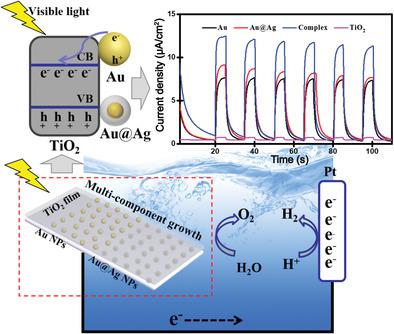当前位置:
X-MOL 学术
›
Adv. Mater. Interfaces
›
论文详情
Our official English website, www.x-mol.net, welcomes your
feedback! (Note: you will need to create a separate account there.)
Growing In‐Plane Multiplex Plasmonic Arrays for Synergistic Enhanced Photocurrent Response
Advanced Materials Interfaces ( IF 4.3 ) Pub Date : 2019-12-17 , DOI: 10.1002/admi.201900966 Wenkai Liang 1 , Dong Li 1 , Yinghui Sun 2 , Ziyang Li 1 , Liang Zhao 2 , Liubiao Zhong 1 , Junchang Zhang 1 , Zhiqiang Liang 1 , Ibrahim Abdulhalim 3 , Lin Jiang 1
Advanced Materials Interfaces ( IF 4.3 ) Pub Date : 2019-12-17 , DOI: 10.1002/admi.201900966 Wenkai Liang 1 , Dong Li 1 , Yinghui Sun 2 , Ziyang Li 1 , Liang Zhao 2 , Liubiao Zhong 1 , Junchang Zhang 1 , Zhiqiang Liang 1 , Ibrahim Abdulhalim 3 , Lin Jiang 1
Affiliation

|
A complete control of the localized surface plasmon resonance (LSPR) properties of different types of metal nanoparticles (size, shape, or composition) in a device by facile techniques with high throughput is crucial to intensively study and apply the LSPR effects to improve device performance. Here, a versatile approach is presented to fabricate macroscopic and in‐plane multiplex arrays of plasmonic nanoparticles with well‐defined particle size or composition allocation. The polymer layer (poly(N‐isopropylacrylamide), PNIPAM) spin‐coated on the surface of the substrate is applied as a protective layer to control the growth of the Au nanoparticles in a dip‐coating procedure. The relative contribution of LSPR of each particle type can be controlled by selectively adjusting the particle size or composition at the desired position of multiplex arrays on the same substrate. A synergistic enhanced photocurrent response is observed in the metal–semiconductor system, which is attributed to broadened LSPR enhancement of multiplex composition (Au and Au@Ag) structures from the same substrate. The fabrication procedure presented in this study is highly repeatable and feasible for preparing ordered multiplex nanostructures on the same substrate. Furthermore, this method provides a cost‐effective and versatile platform for design of multiplex plasmonic nanostructures in sensing, solar energy conversion, and optical processing applications.
中文翻译:

平面内多重等离激元阵列的增长,以增强协同的光电流响应。
通过高通量的简便技术完全控制设备中不同类型的金属纳米粒子(尺寸,形状或组成)的局部表面等离子体共振(LSPR)特性,对于深入研究和应用LSPR效应以改善设备性能至关重要。 。在这里,提出了一种通用方法来制造具有明确定义的粒径或成分分配的等离激元纳米粒子的宏观和平面内多重阵列。旋涂在基材表面的聚合物层(聚(N-异丙基丙烯酰胺)(PNIPAM))被用作保护层,以控制浸涂过程中金纳米颗粒的生长。每种粒子类型的LSPR的相对贡献可以通过有选择地调整同一基质上多重阵列所需位置的粒径或组成来控制。在金属-半导体系统中观察到协同增强的光电流响应,这归因于同一基材上多重成分(Au和Au @ Ag)结构的LSPR增强。在这项研究中提出的制造过程是高度可重复的,并且对于在同一基板上制备有序的多重纳米结构是可行的。此外,该方法为传感,太阳能转换和光学处理应用中的多重等离子体纳米结构的设计提供了一种经济高效的通用平台。在金属-半导体系统中观察到协同增强的光电流响应,这归因于同一基材上多重成分(Au和Au @ Ag)结构的LSPR增强。在这项研究中提出的制造过程是高度可重复的,并且对于在同一基板上制备有序的多重纳米结构是可行的。此外,该方法为传感,太阳能转换和光学处理应用中的多重等离子体纳米结构的设计提供了一种经济高效的通用平台。在金属-半导体系统中观察到协同增强的光电流响应,这归因于同一基材上多重成分(Au和Au @ Ag)结构的LSPR增强。在这项研究中提出的制造过程是高度可重复的,并且对于在同一基板上制备有序的多重纳米结构是可行的。此外,该方法为传感,太阳能转换和光学处理应用中的多重等离子体纳米结构的设计提供了一种经济高效的通用平台。在这项研究中提出的制造过程是高度可重复的,并且对于在同一基板上制备有序的多重纳米结构是可行的。此外,该方法为传感,太阳能转换和光学处理应用中的多重等离子体纳米结构的设计提供了一种经济高效的通用平台。在这项研究中提出的制造过程是高度可重复的,并且对于在同一基板上制备有序的多重纳米结构是可行的。此外,该方法为传感,太阳能转换和光学处理应用中的多重等离子体纳米结构的设计提供了一种经济高效的通用平台。
更新日期:2019-12-17
中文翻译:

平面内多重等离激元阵列的增长,以增强协同的光电流响应。
通过高通量的简便技术完全控制设备中不同类型的金属纳米粒子(尺寸,形状或组成)的局部表面等离子体共振(LSPR)特性,对于深入研究和应用LSPR效应以改善设备性能至关重要。 。在这里,提出了一种通用方法来制造具有明确定义的粒径或成分分配的等离激元纳米粒子的宏观和平面内多重阵列。旋涂在基材表面的聚合物层(聚(N-异丙基丙烯酰胺)(PNIPAM))被用作保护层,以控制浸涂过程中金纳米颗粒的生长。每种粒子类型的LSPR的相对贡献可以通过有选择地调整同一基质上多重阵列所需位置的粒径或组成来控制。在金属-半导体系统中观察到协同增强的光电流响应,这归因于同一基材上多重成分(Au和Au @ Ag)结构的LSPR增强。在这项研究中提出的制造过程是高度可重复的,并且对于在同一基板上制备有序的多重纳米结构是可行的。此外,该方法为传感,太阳能转换和光学处理应用中的多重等离子体纳米结构的设计提供了一种经济高效的通用平台。在金属-半导体系统中观察到协同增强的光电流响应,这归因于同一基材上多重成分(Au和Au @ Ag)结构的LSPR增强。在这项研究中提出的制造过程是高度可重复的,并且对于在同一基板上制备有序的多重纳米结构是可行的。此外,该方法为传感,太阳能转换和光学处理应用中的多重等离子体纳米结构的设计提供了一种经济高效的通用平台。在金属-半导体系统中观察到协同增强的光电流响应,这归因于同一基材上多重成分(Au和Au @ Ag)结构的LSPR增强。在这项研究中提出的制造过程是高度可重复的,并且对于在同一基板上制备有序的多重纳米结构是可行的。此外,该方法为传感,太阳能转换和光学处理应用中的多重等离子体纳米结构的设计提供了一种经济高效的通用平台。在这项研究中提出的制造过程是高度可重复的,并且对于在同一基板上制备有序的多重纳米结构是可行的。此外,该方法为传感,太阳能转换和光学处理应用中的多重等离子体纳米结构的设计提供了一种经济高效的通用平台。在这项研究中提出的制造过程是高度可重复的,并且对于在同一基板上制备有序的多重纳米结构是可行的。此外,该方法为传感,太阳能转换和光学处理应用中的多重等离子体纳米结构的设计提供了一种经济高效的通用平台。











































 京公网安备 11010802027423号
京公网安备 11010802027423号